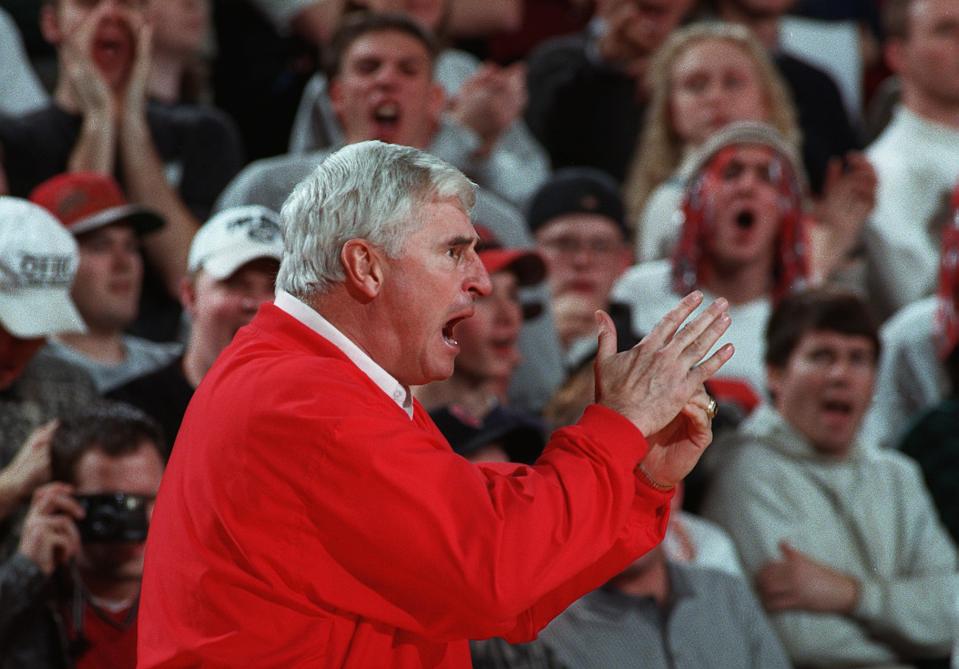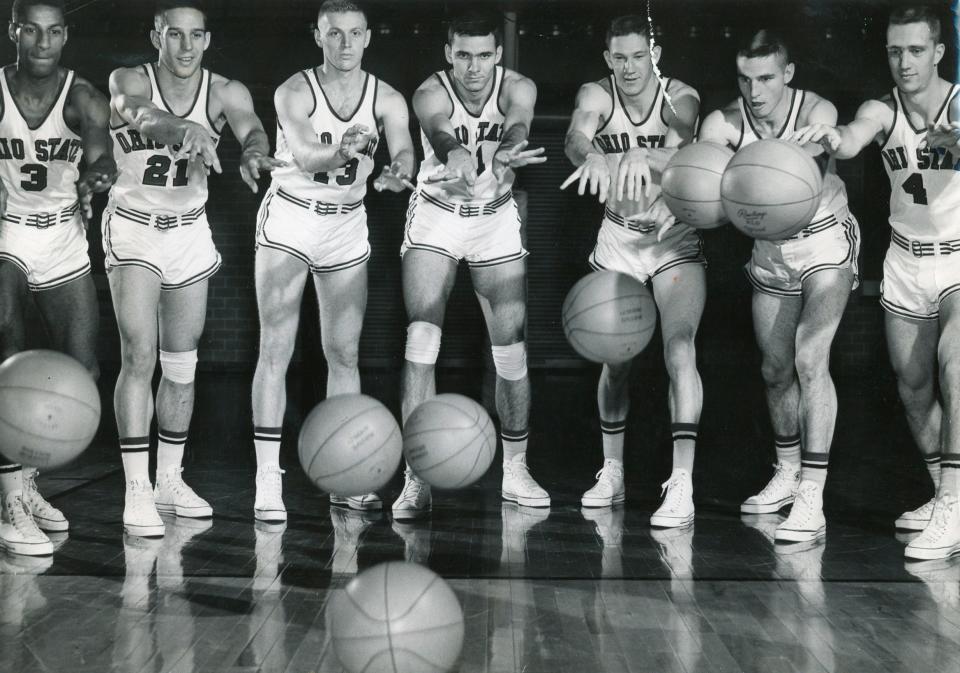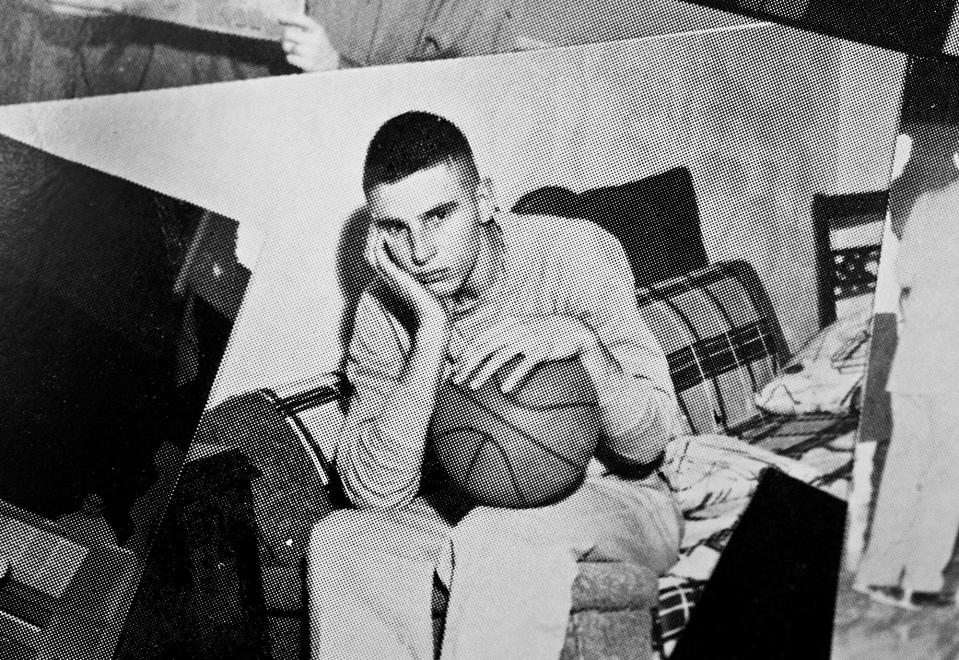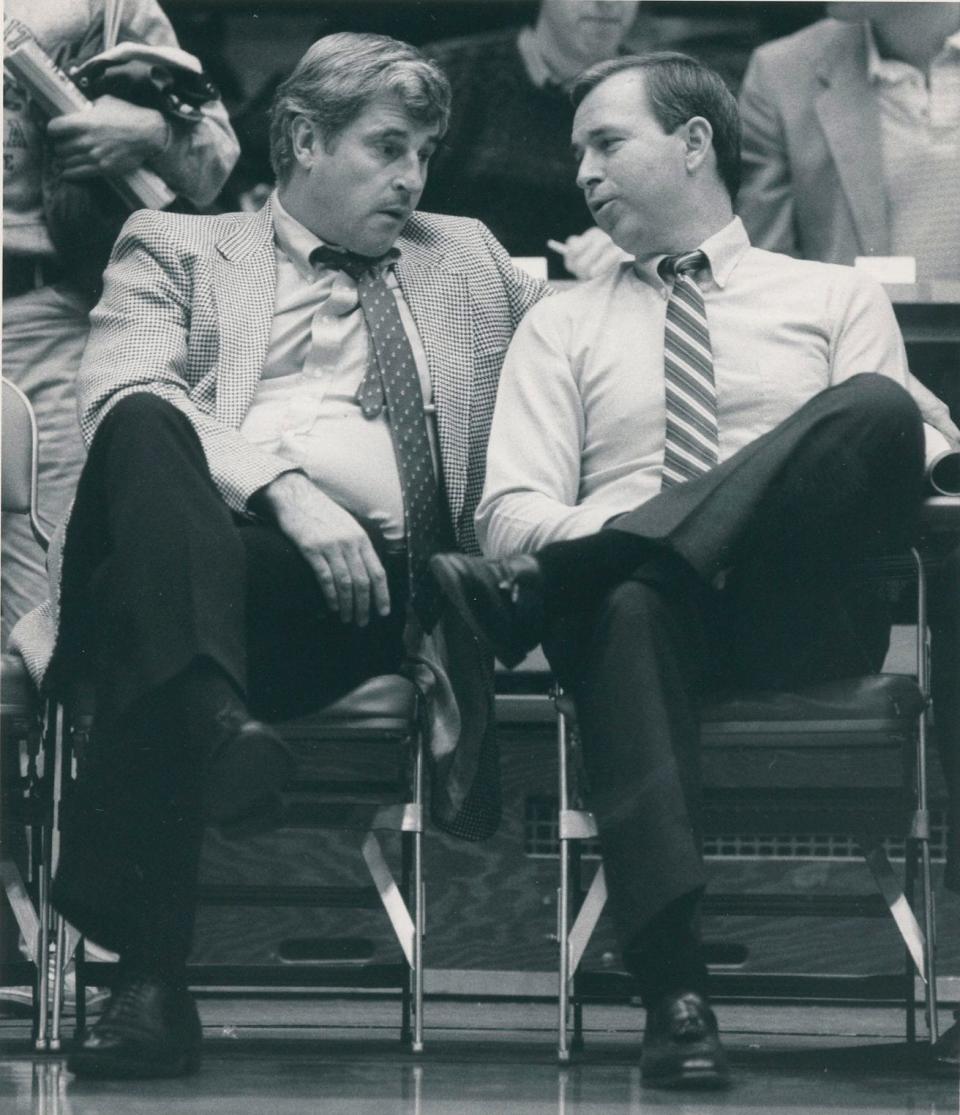Arace: Bobby Knight made himself in Indiana, but he was made in Ohio. He never forgot it
Bobby Knight died Wednesday at his home in Bloomington, Indiana, surrounded by family. He was 83 years old, and under hospice care. While no cause of death was provided, his oldest friends knew he had been in declining health for years. His family asked that, in lieu of flowers, folks consider honoring his memory by donating to the Alzheimer’s Association or Marian University, “which is distinguished in its ability to prepare transformative leaders for service to the world.”
Knight was one of the greatest coaches in the history of college basketball. He won 903 games, most of them at Indiana, where he coached from 1971-2000. He won three national titles with the Hoosiers (1976, 1981, 1987) and, with the national team, an Olympic gold medal (1988). He perfected a motion offense that went mainstream. His attention to detail was absolute and his man-to-man defense was fierce.
Within hours of his passing, tributes, assessments and criticisms of the man littered the World Wide Web. Attempts were made to balance the life of a coach who graduated 90% of his athletes, ran a squeaky-clean program, retired as college basketball’s all-time winningest coach with the coach who did not control his temper, did some incredibly stupid things and, at times, did not hold himself to the same level of accountability that he demanded from nearly everyone else around him.
“I’ve always told people: If Bob was 10% less intense, everyone probably would have loved him,” said Dick Furry, who was a senior co-captain for Ohio State when the Buckeyes won the NCAA title in 1960. Knight was a sophomore who came off the bench that season.
“His insistence on doing things the right way was too much for some people to handle, Furry said. “For those that knew him well, he was a dear, dear friend.”

In this space, the focus is on the Buckeye. Knight may have made his bones in Indiana, but he was made in Ohio, and he never forgot it.
Robert Montgomery Knight was born in Massillon, in northeast Ohio, on Oct. 25, 1940. He came into the world about a month before Massillon High football coach Paul Brown finished off another undefeated season, about two months before Brown accepted the job at Ohio State and about two years before Brown led the Buckeyes to their first national title in football.
Knight grew up in Orrville, which, while just 20 miles away from Massillon, is a completely different world. Orrville is rural, small-town Midwest, and not as football mad as Massillon. Knight’s father, Pat, worked for the railroad and his mother, Hazel, was an elementary school teacher. His maternal grandmother lived with them in a small brick house on Vine Street, and she taught young Bobby to respect his elders.
In 2011, Dispatch sportswriter Todd Jones did a piece on Knight’s hometown and wrote of Orrville as a place “where the Smucker’s plant is the economic core, parking downtown is free and quaint values reign as if Ike stopped time.”
Knight regularly returned to Orrville to hunt and fish and just hang out with old friends. Over the years, he donated directly or helped raise hundreds of thousands of dollars to the Orrville library, the athletic booster club, the high school and other local concerns. Ask most anyone who knew Knight in Ohio or, for that matter, in Bloomington, and they will tell you that Knight’s public generosity paled in comparison to what he did quietly, with no fanfare.
“Nobody has done more for more people than Bobby has,” said another Ohio State teammate, Gary Gearhart. “There wasn’t a kid he wouldn’t reach out to if someone asked him to. He did things people knew about, but that wasn’t why he did them. He did a lot more things nobody knew about because he didn’t want anyone to know. That was Bobby.”

Knight was a three-sport star at Orrville High in the 1950s. Knight’s high school teams did not win state championships. He was not an All-State player. But he had some serious game and, surprise, a ton of confidence.
“The first time I was in a group of players being recruited by Ohio State, I remember being under the basket while we were just shooting around,” said Mel Nowell, a teammate and classmate of Knight’s. “Suddenly, shots started hitting the back of the rim and shooting straight down through the net. It was Bobby back there, shooting from long, long range, and shooting with accuracy. I said, ‘Who is that?’
“When he got the ball, if a defender didn’t get on him quick, his shot was gone. He didn’t mind shooting. If you passed it to him, you didn’t expect to get it back. You didn’t expect him to go down and set a pick for you.”
There is a smile in Nowell’s voice as he says this. Why? Because Nowell wasn’t exactly a pass-first guy, either.
Knight was a part of the famed “Super Sophs” class that was integral to the 1960 championship team – the first and last to win a basketball title at Ohio State. The “Super Sophs” included three starters on that 1960 squad – Middletown’s megastar Jerry Lucas, a future Hall of Famer, Bridgeport’s John Havlicek, a future Hall of Famer, and Nowell, a Columbus East legend who went on to play in the NBA and ABA.

The other two sophomores, Gearhart, from New Lebanon, and Knight were roommates. They spent a lot of time together on the bench. They became best friends for life.
“Together,” Nowell said, “we won three Big Ten titles, one national championship and made it to the NCAA final three years in a row. Remember, this was at a time when freshmen were ineligible to play. You want to know how good Bobby was? Well, he was a part of all of that.”
In the 1961 championship game, Knight came off the bench with 1:41 to play and Ohio State trailing Cincinnati by three points. Nowell remembers what happened next: “He drove around somebody with a crossover and swooped in for a layup, and I was like, ‘Jeeze, where did that come from?’ He was a talented guy, and it went beyond his outside shooting.”
A Knight obituary in the Los Angeles Times recounted the same moment as told by assistant coach Frank Truitt, who said, “That tied the game for us and Knight ran clear across the court like a 100-yard dash sprinter and ran right at me and said, ‘See there, Coach, I should have been in the game a long time ago.’”
To which Truitt replied, “Sit down, you hot dog. You’re lucky you’re even on the floor.”
If you close your eyes, can’t you see, or at least feel, the precociousness of a 21-year-old Bobby Knight? The head coach was Hall of Famer Fred Taylor, who became the model for Knight’s Hall-of-Fame career.
“There was a great deal to learn from Fred,” Nowell said, “and Bobby was smart enough to pick up on that.”
Ohio State lost to Cincinnati in the NCAA title game in 1961 (70-65) and 1962 (71-59). Knight finished his playing career in Columbus with 74 games played and averages of 3.8 points and 1.5 rebounds. He was usually the first or second man off the bench. He never started.
“Bobby and I spent a lot of time on the bench,” Gearhart said. “Both of us wanted more playing time. I think as time went on, Bobby realized what Fred was dealing with – we had a lot of talent. I think when Bobby became a coach, he realized what it took to manage players, and his respect for Fred Taylor grew even more.”
Said Furry, the co-captain, “He could really play. He was our seventh-leading scorer in 1960, but we were really a six-man team until it was time to mop up. At 6-4, he was just a bit undersized as a forward, and that was a problem even back then. But he was a real student of the game. Obviously.”
Knight and his college teammates maintained an incredibly tight bond over the following six-plus decades. They regularly exchanged phone calls or texts, visited one another frequently and had a blast every time they were all reunited. For 40 years, Bloomington, as much as Columbus, was the crossroad of their coast-to-coast travel.
This was a unique group. Sure, each of the 1960 starting five went on to play in the NBA and three of them, Lucas, Havlicek and Larry Siegfried, won NBA titles as players. But that was not the way they measured themselves. Usually, they used their team GPA, which was north of 3.5. They became doctors, lawyers, businessmen, art collectors. Most of them had advanced degrees. Co-captain Joe Roberts, who won an NBA ring as an assistant coach with the 1975 Golden State Warriors, had four post-graduate degrees, one from Stanford. Roberts died last year.

Lucas always defined the 1960 “team” as a 12-man traveling contingent, plus four more who rounded out the roster, plus the team manager. Eight of the 12-man traveling contingent are now gone; five have died in the last three years. Those who remain are hurting right now as they remember one of the most durable and incorruptible friends they’ve ever had.
“Loyal,” said Dave Barker, another teammate of Knight’s in 1960. “Lionhearted. More a teacher than a coach, that’s what he really was. He was sure to win ballgames, but he was really there to mold men, and nobody is going to change my mind on that. Hard shell, soft interior. Fair. A different person than he was on TV.”
Said Gearhart, “I know some people have a certain idea of who he was. I know that some of the things he said and did, some people can’t forgive him, and I understand that. But I never had a better or closer friend for 64 years. I miss him. I’ve missed him for the last six months, when things got really bad (with Knight’s health). If you knew that man, you loved him.”
In American culture, Knight is a caricature whose coaching brilliance brought him fame and fortune and whose flaws, magnified on the public stage, made him into a garish figure. Among his oldest and most ardent friends, he is just that – an old and ardent friend.
“So many people are saying a lot of things,” Lucas said, almost defiantly. “I only have a few words to say – I love Bobby. Period. That’s my statement. People are saying all kinds of things about Bobby. I love Bobby. And that’s it.”
Check out the BuckeyeXtra Basketball podcast
This article originally appeared on The Columbus Dispatch: A look at Bobby Knight's championship years at Ohio State University

